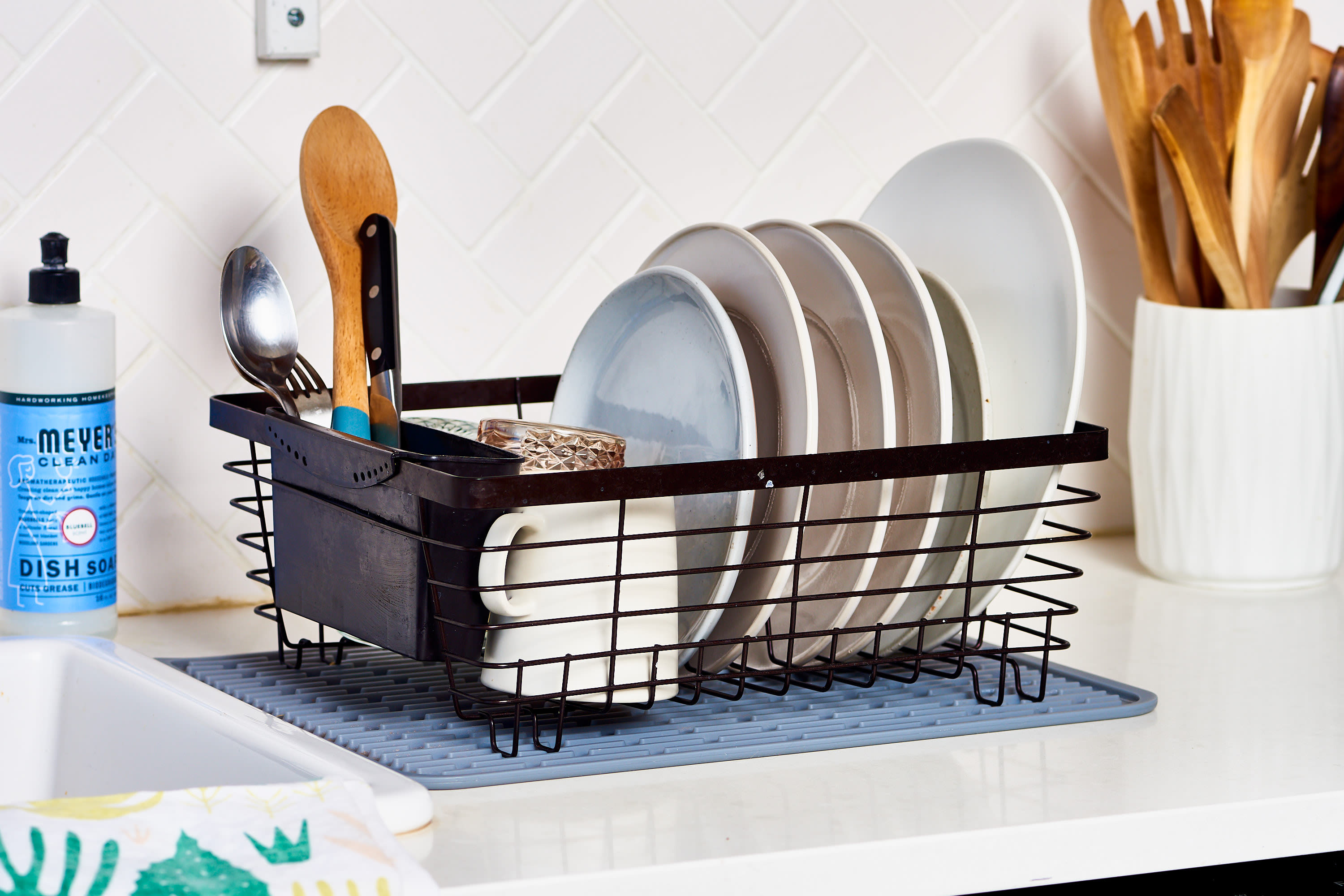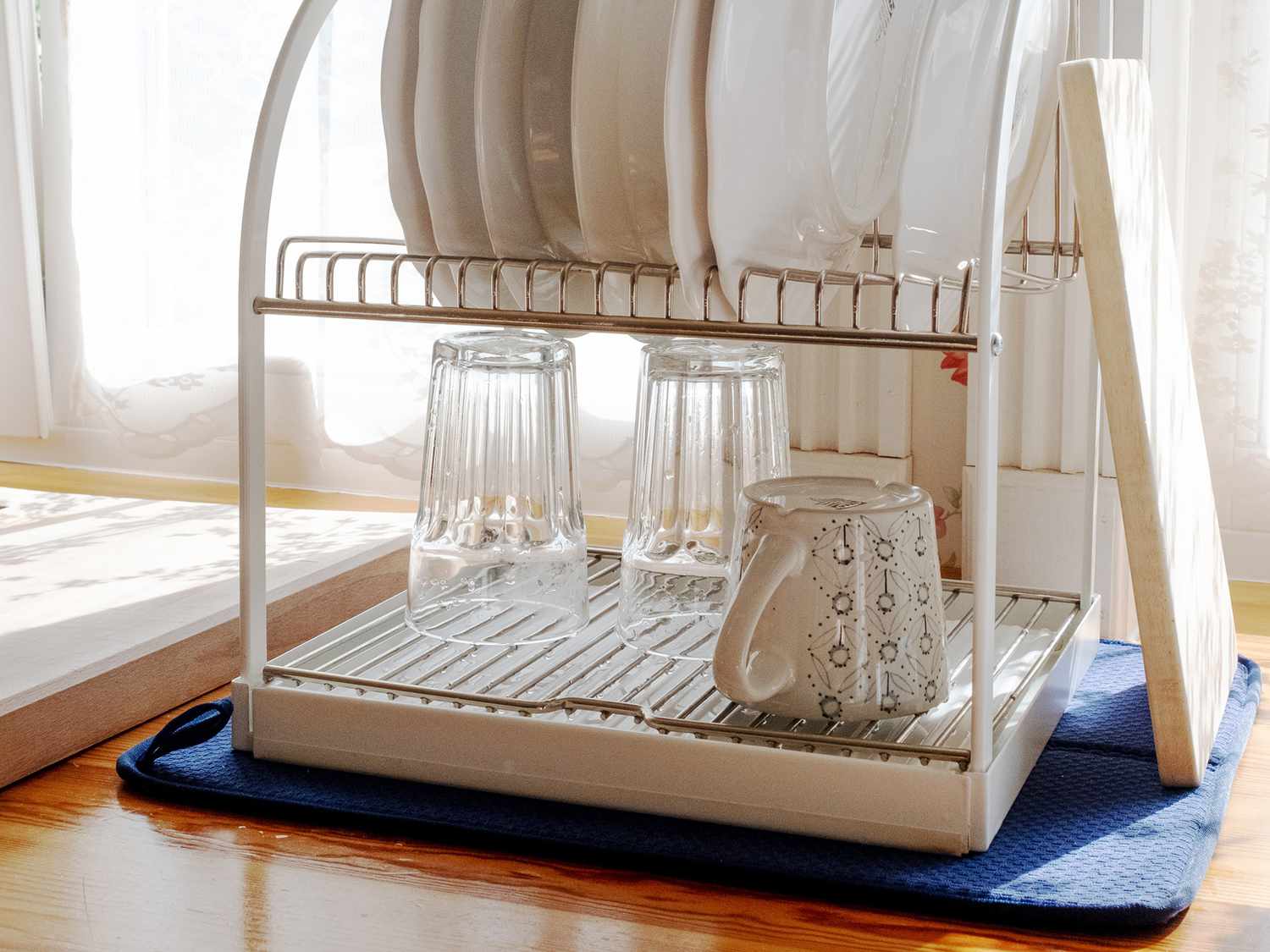Dish drying mats are made of absorbent materials that can wick away moisture from dishes and glasses placed on them. However, if they are not properly cared for, they can become moldy. To prevent this, rinse the mat after each use and hang it up to dry in a well-ventilated area.
Inspect the mat regularly for any signs of mold and clean it immediately if you notice any.
If you’ve ever had a dish drying mat, you know that they can be a lifesaver. But what happens when your dish drying mat starts to get moldy? Here’s what you need to know about keeping your dish drying mat clean and free of mold.
Dish drying mats are great for absorbing water from wet dishes and preventing them from getting your countertop wet. However, over time, they can start to harbor mold and mildew if they’re not properly cleaned. To prevent this from happening, make sure to wash your dish drying mat regularly with hot water and soap.
You can also soak it in a mixture of vinegar and water overnight to kill any mold or mildew that may be growing on it.
If your dish drying mat does start to get moldy, don’t panic! You can easily clean it with a mixture of baking soda and water.
Scrub the affected areas with this mixture, then rinse well with hot water. If the mold persists, you may need to repeat the process or throw out the dish drying mat altogether.
In general, it’s best to avoid letting your dish drying mat get too wet or dirty in the first place.
After each use, wring out any excess water and hang it up to dry completely before storing it away. This will help prolong its life and keep it free of mold and mildew growth.
How to get mold off of clothes and dish drying pad
How to Remove Mold from Dish Rack
Mold and mildew can form on dish racks if they are not cleaned often enough. To remove mold from a dish rack, start by scrubbing it with a brush to loosen any dirt or grime. Then, soak the rack in a vinegar and water solution for 30 minutes to kill the mold spores.
After soaking, rinse the dish rack with clean water and dry it thoroughly before using it again.
How to Clean Cloth Dish Drying Mat
If you have a dish drying mat, chances are you use it often to dry your dishes. Over time, the mat can become stained and grimy. But don’t worry – with a little bit of care, you can keep your dish drying mat looking like new.
Here’s how:
To start, remove any food or grease stains by scrubbing them with a mild detergent. You may need to use a brush to get stubborn stains out.
Rinse the area well and allow it to air dry.
Next, disinfect the mat by mixing 1 part bleach with 10 parts water. soak a clean cloth in the solution and wring it out before wiping down the entire surface of the mat.
Allow it to air dry completely before using it again.
Finally, if your dish drying mat starts to smell musty, simply place it in the sun for a few hours to freshen it up naturally.
With these simple tips, your dish drying mat will last for years to come!
Washing Up Drying Mat
If you’re like most people, washing dishes is not your favorite chore. But it’s a necessary evil if you want to eat off of clean plates and cookware. One way to make the task a little less tedious is to use a dish drying mat.
A dish drying mat is a absorbent mat that you can place your wet dishes on after they’ve been washed. The mat will help to wick away water and keep your counters dry. Dish drying mats come in a variety of sizes and materials, so you can find one that fits your needs.
If you’re looking for an eco-friendly option, choose a dish drying mat made from natural fibers like bamboo or hemp. If you’re concerned about mold or mildew, look for a mat that has built-in anti-microbial properties. And if space is tight in your kitchen, choose a compactmat that can be rolled up when not in use.
No matter which type of dish drying mat you choose, it’s sure to make doing the dishes just a little bit easier!
Can You Put Dish Drying Mat in Dryer
If you’ve ever wondered if you can put your dish drying mat in the dryer, the answer is yes! Dish drying mats are designed to be durable and can withstand high temperatures, so they won’t shrink or warp in the dryer. Just make sure to remove the mat from the dryer as soon as it’s done cycle, as letting it sit in there for too long can cause mildew or mold to form.

Credit: www.apartmenttherapy.com
How Do I Keep My Dish Drying Rack from Molding?
If you’re like most people, you probably have a dish drying rack that you use to air-dry your dishes after washing them. And if you’re like most people, you’ve probably also had the experience of coming back to your dish drying rack after a few days to find it covered in mold.
So how do you keep your dish drying rack from molding?
The first thing you need to do is make sure that your dish drying rack is made of materials that won’t promote the growth of mold. Most dish racks are made of either plastic or metal, and both of these materials can be treated to prevent the growth of mold. You can buy special anti-mold sprays at most hardware stores, or you can make your own by mixing one part bleach with ten parts water.
Once you’ve treated your dish rack, make sure to dry it off completely before storing it away. Mold loves damp environments, so if there’s even a little bit of moisture on your dish rack when you put it away, chances are good that mold will start growing on it within a few days.
If possible, try to store your dish rack in a cool, dry place when not in use.
A cabinet or pantry would be ideal; if those aren’t options for you, simply put your dish rack on top of a towel when not in use so that any moisture will be absorbed by the towel instead of sitting on the surface of the Rack itself.
How Sanitary are Drying Mats?
If you’re like most people, your kitchen is probably one of the busiest rooms in your home. Whether you’re cooking a meal for your family or entertaining guests, there’s always something going on in the kitchen. And with all that activity, it’s no wonder that accidents happen.
spills and messes are just part of life. But when it comes to cleaning up those messes, you want to make sure you’re using products that are safe and effective. That’s why we’ve put together this guide to help you choose the best drying mat for your needs.
Drying mats are designed to protect your countertops from wet dishes and glassware. They also provide a place to air-dry washed fruits and vegetables. Most drying mats are made of absorbent materials like cotton or microfiber which can quickly wick away water droplets before they have a chance to damage your surfaces.
When shopping for a drying mat, look for one that is machine-washable so you can easily keep it clean. You’ll also want to make sure the mat is large enough to accommodate all of your dishes and glassware without overcrowding. And finally, consider opting for a mat with anti-skid backing which will help prevent it from slipping around on your countertop as you use it.
How Do You Keep a Dish Drying Mat Clean?
If you’re like most people, your dish drying mat probably doesn’t get a lot of love or attention. But it’s an important part of your kitchen, and keeping it clean is crucial to making sure your dishes are as clean as possible. Here are some tips for keeping your dish drying mat clean and bacteria-free:
1. Wash it regularly. Just like any other item in your kitchen, you should wash your dish drying mat on a regular basis. Aim to wash it at least once a week, using hot water and soap.
If you have a machine-washable mat, you can throw it in the washing machine with your other laundry.
2. Let it air dry. After washing your dish drying mat, make sure to let it air dry completely before using it again.
This will help prevent any bacteria from growing on the mat.
3. Don’t forget the nooks and crannies. When cleaning your dish drying mat, pay special attention to any nooks or crannies where dirt and grime can build up.
Use a brush or toothbrush to reach these areas and scrub them clean.
4. Store it in a clean place . .
Can Mold Grow in Dish Racks?
Yes, mold can grow in dish racks. This is because dish racks are often made of porous materials, such as wood or plastic, which can absorb moisture. Mold needs moisture to grow, so if there is water or dampness present in a dish rack, mold will likely start to grow.
In addition, dish racks are often located in moist areas, such as near sinks or in cabinets under the sink, which can also contribute to the growth of mold.
Conclusion
Dish drying mats are a great way to air-dry your dishes after washing them. However, if you don’t clean and dry your dish drying mat regularly, it can get moldy. To prevent your dish drying mat from getting moldy, be sure to wash it with soap and water after each use.
Then, let it air-dry completely before storing it away.


